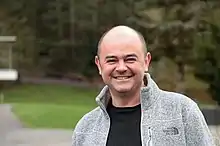Laurent Fargues
Laurent Fargues (born 19 July 1975 in Cagnes-sur-Mer) is a French mathematician working in number theory and arithmetic geometry.
Laurent Fargues | |
|---|---|
 Laurent Fargues | |
| Born | 19 June 1975 Cagnes-sur-Mer |
| Nationality | French |
| Scientific career | |
| Fields | Mathematics |
| Thesis | Correspondances de Langlands locale dans la cohomologie des espaces de Rapoport-Zink. |
| Doctoral advisor | Michael Harris |
Fargues was an invited speaker at the International Congress of Mathematicians in 2018 in Rio de Janeiro.
Career
From 2002 to 2011, Fargues was a chargé de recherches at the CNRS in Orsay, from 2011 to 2013 he was CNRS research director at the IRMA in Strasbourg and, from 2013, CNRS research director at the l'Institut de mathématiques de Jussieu in Paris (a campus of the Sorbonne University).[1]
Fargues works mainly centers around the study of Shimura varieties, p-divisible groups and their moduli spaces, and p-adic Hodge theory. One of his most significant contributions has been to link the local Langlands correspondence with the so-called "Fargues-Fontaine curve," an object introduced by Fargues together with Jean-Marc Fontaine. In particular, Fargues has formulated a general geometric conjecture[2] which refines the classical local Langlands conjecture, and at the same time introduces extra structure which mirrors the more categorical formulation of the geometric Langlands conjecture. These works were (in part) the subject of a Séminaire Bourbaki exposé in 2018 by Matthew Morrow[3] and an Arbeitsgemeinschaft meeting at Oberwolfach in 2016.[4] His work with Peter Scholze on the stack of vector bundles on the Fargues-Fontaine curve is expected to have implications for the construction of a local Langlands correspondence for general groups.[5]
Fargues gave the Peccot course at the Collège de France in the spring of 2004, was awarded the Petit d'Ormoy, Carriere, Thebault prize from the French academy of sciences in 2009, and was an invited speaker at the International Congress of Mathematicians 2018 in Rio de Janeiro[6] in both the number theory and algebraic geometry sessions.
References
- "Laurent Fargues, CV (English)" (PDF). Personal home page.
- "Geometrization of the local Langlans correspondence: an overview" (PDF).
- "The Fargues-Fontaine curve and diamonds, d'après Fargues, Fontaine, and Scholze" (PDF). bourbaki.ens.fr.
- "Geometric Langlands,Perfectoid Spaces,and the Fargues-Fontaine Curve" (PDF).
- Michael Rapoport (28 December 2018). "The Work of Peter Scholze" (PDF). Proc. Int. Cong. of Math. Rio de Janeiro. 1: 71–86. Retrieved 26 September 2019.
- The curve and the Langlands program – Laurent Fargues – ICM2018, retrieved 29 September 2019